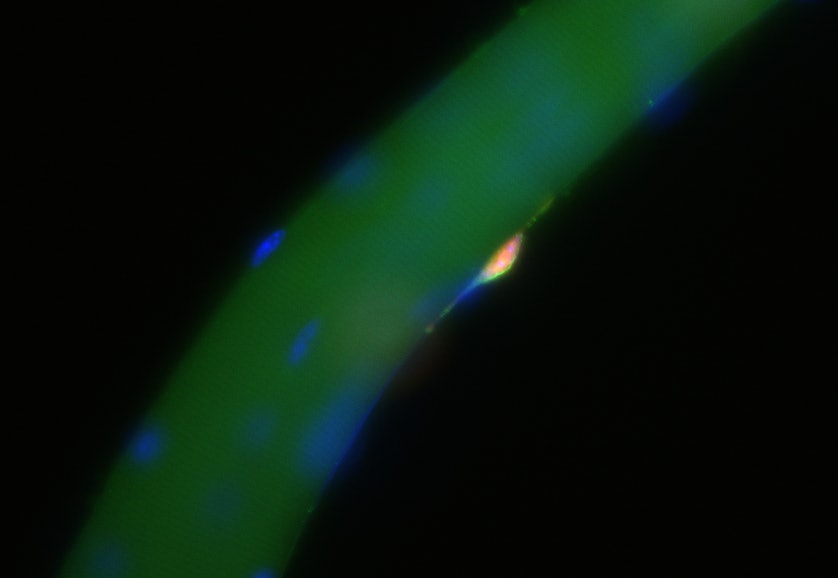
Walk into any cosmetics store and turn into the skincare aisle. Among all the lotions and potions, you will find it hard to avoid the reigning heavyweight of anti-aging ingredients: hyaluronic acid. This sugar molecule typically found in the body reportedly delivers some serious benefits, from ironing out wrinkles and plumping skin to safeguarding eye and joint health.
Now hyaluronic acid can add revitalizing muscles to its glowy resume, according to a paper published Thursday in Science. Researchers discovered that after muscle damage, hyaluronic acid swoops in and nudges muscle stem cells to get cracking on making repairs. The finding could lead to interventions that boost our bodies’ mending mechanisms, particularly in people who experience severe trauma or injury or those with a muscle-wasting condition like muscular dystrophy.
Alec Smith, a regenerative medicine researcher at the University of Washington’s Institute for Stem Cell and Regenerative Medicine, who was not involved in the study, says that this finding may help individuals who lose and can’t grow back muscle due to extensive trauma, such as gunshot wounds or car accidents.
“The big goal in this area of muscle regeneration is to work out how we can enhance the process to allow people to overcome more significant wounds,” he explains to Inverse.

Here’s the background — Scientists already knew that muscle stem cells help out with the healing process and are critical to muscle regeneration. But they tend to arrive long after inflammation sets in, Jeff Dilworth, the study’s lead researcher, and an epigeneticist at The Ottawa Hospital Research Institute in Canada, tells Inverse.
“What happens after muscle injury is that there’s inflammation, immune cells come into the injured muscle to remove damaged tissues,” he says. “Your muscle doesn’t want to waste making new muscle until you’ve got the inflammation resolved so stem cells don’t actually start working until almost two days after injury.”
During inflammation, immune cells like macrophages (which eat injured cells) spit out a deluge of chemicals called cytokines, which tell other cells what to do. To muscle stem cells, also called satellite cells, cytokines tell them not to wake up until most of the inflammatory storm is over.
The discovery — How exactly muscle stem cells can counter their chemical snooze button and activate themselves has boggled scientists for some time. Dilworth and his team stumbled across hyaluronic acid’s role when investigating an enzyme — a protein that acts as a biological catalyst to speed up chemical reactions in cells — that seemed to work only during inflammation.
Looking at mice and muscle cells grown in Petri dishes, the researchers found that in response to the influx of cytokines, the enzyme JMJD3 rouses muscle stem cells awake. More specifically, the enzyme cozies up to a gene involved in hyaluronic acid production called Has2.
“The stem cells, as it’s receiving those signals [from cytokines], is going to start making hyaluronic acid and coats itself,” explains Dilworth. “[This] sort of creates a force field or a barrier around [the muscle stem cells] that’s going to protect it from these negative signals coming from the cytokines.”
Once that happens, muscle stem cells covered in hyaluronic body armor amass at the site of injury in droves. They start replicating, expanding the workforce available to restore and make new muscle.

Why it matters — While this is a mouse study and needs studies involving humans to validate the results, “this is a really exciting finding,” says Anthony Atala, director of Wake Forest University’s Intitute for Regenerative Medicine. He was not involved in the study.
“It’s basically advancing our knowledge of how muscle regenerates. It’s also advancing our knowledge of how to make sure we can overcome the challenges for regeneration.”
These challenges lie in tackling diseases that affect the muscles, like muscular dystrophy, which currently has no cure and where gene mutations interfere with healthy muscle growth, leading to a gradual, debilitating, and life-threatening muscle loss. Experiencing acute trauma, like a car accident, results in a similar issue.
Currently, there are efforts to hack or jumpstart the regeneration process using medication, small molecule therapies, and gene therapies — but these are all very much experimental.
“This [study] is a really valuable piece of the puzzle,” says Smith. “But we’re going to still need to understand more about how exactly the regeneration is activated to be able move towards designing therapies that can enhance muscle regeneration.”
What’s next — Dilworth and his team are continuing their investigations to fully suss out the dynamic between hyaluronic acid, muscle stem cells, and inflammation and whether other chemical or cellular players are involved.
“We’re going to use [this research] as a tool for basic science to try and understand the complete pathway of communication between the immune system and the stem cell, which is poorly defined at the moment,” he says.
The researchers want to channel their findings into clinical applications, like finding ways to turn up hyaluronic acid production in the muscle stem cells of older people.
Until then, Dilworth does not recommend you slap some hyaluronic acid to that achy, bruised muscle and hope for a miracle. That definitely won’t work — better to save the tonic for your face instead (for now).







